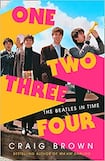
Do we really need another Beatles book? After epic works like Ian MacDonald’s Revolution in the Head and Philip Norman’s Shout!, aren’t further studies a bit superfluous?
Were The Beatles even that good? Compared to Dylan’s innovation, the Stones’ swagger, the Doors’ menace, Bowie’s imagination, The Clash’s urgency or Nirvana’s intensity, did they produce anything other than tunes for the postman to whistle?
Pardon the devil’s advocate angle. Some of us feel like the only atheist at a papal Mass when it comes to the fetishisation of the Fabs, about whom it’s perfectly feasible to hold two opposing thoughts: (a) Strawberry Fields/A Day in the Life/Penny Lane/Eleanor Rigby are among the greatest songs ever written; (b) the band are grievously overrated.
Craig Brown’s One Two Three Four: The Beatles In Time is equal parts social history, oral history, memoir and conventional pop biography. Its scope is kaleidoscopic, placing the quartet at the centre of a universe orbited by Elvis Presley, Princess Margaret, Judy Garland, Muhammad Ali, Philip Larkin, Marlene Dietrich, the Queen of England and thousands more.
Brown is a veteran journalist and prolific author, but it’s his irreverent wit, honed over years of working at Private Eye, that distinguishes this book. He understands that long before the rapacious repackaging of the Fabs’ back catalogue, before the National Trust tours and grotesque tribute acts, before the theme park tat and cinematic fan fantasias like Danny Boyle’s Yesterday and Julie Taymor’s Across the Universe, before the cute suits and moptops even, The Beatles were born greasers.
If not for Brian Epstein and George Martin, these four toe-rags might have ended their days playing rhythm and blues for bikers in Bognor. (Fact: it aggravated John Lennon no end that the Rolling Stones, middle-class suburban lads, were cast as the bad boys of Swinging London, while the more petable-looking Beatles were the true toughs, Liverpudlian punks in black leather who survived Hamburg by necking uppers and booze, getting into fights and undergoing sexual initiation rites with Reeperbahn prostitutes.)
Grabby start
Brown’s book goes for a grabby start and holds the tempo from then on. The necrophiliac rock heritage industry loves to cultivate its legends, the sticky myth-stuff calcifying around its subjects, but Brown strips away the stale iconography, ripping the unmerciful piss out of the Beatles nostalgia mill, rendering John, Paul, George and Ringo all too human again in the process.
Sometimes it’s the unlikely details that get you: daft little footnotes like the Hamburg club fraternity’s nickname for the band, “The Peadles” (meaning “little penis” in German); the author’s multi-cam breakdown of those epochal 1964 Ed Sullivan appearances, characterised as shamanic rites of musical healing that ushered in the promise of spring again after the terrible winter of JFK’s murder; a sympathetic but unsentimental survey of the collateral damage caused by Beatlemania, with hundreds of MOR crooners made redundant overnight.
And behind the cheeky-chappy anecdotes are some very dark materials. Consider the cold-hearted ousting of Pete Best, who subsequently attempted suicide after several years of slicing bread for a living. Or the sorry tale of Jimmie Nicol, who once subbed for Ringo on an Australian tour and never quite recovered from his few weeks in the spotlight, playing out the rest of his days in a haze of resentment.
Some believed the Stones to be cursed, but the Beatles exerted their own black hole gravitational suck, a field of bad karma that ranged across the death of playwright Joe Orton (murdered just weeks after concluding work on an unproduced Beatles film script), Brian Epstein’s overdose, Charles Manson’s obsession with the White Album, and of course the killing of John Lennon.
Post-war class system
So does this book convince us that the Beatles had anything to declare other than a few catchy little ditties?
Well, yes. Brown is persuasive on how the band did more to dismantle England’s post-war class system than any number of angry young playwrights or social realist film-makers. They simply ignored it, enlivening snooty society dos and OBE ceremonials with swift and sarky wit.
Pre-Beatles the idea of commoner musicians mixing it with royalty and old money was unthinkable, but by 1966 upper-crust socialites were queueing up for a bit of rough: “Writing in the Daily Express that year, Robin Douglas-Home, a Scottish aristocrat, recognised that London’s ‘privileged class’ was now ‘actors, pop singers, hairdressers, and models’. Times, he said, had changed. ‘If a 14th Earl with a grouse moor and George Harrison with Pattie Boyd walked together into a restaurant and there was only one table left, who would be given the table?”
True, as songwriters the band could only occasionally match the observational insights or political bite of a Bob Dylan or Ray Davies. But Lennon’s pathological punnery, his love of nonsense poetry as an act of class subversion, followed a through-line from Edward Lear and Lewis Carroll to the Goons to “I Am the Walrus” (the latter an inspired piece of gobbledegook written in response to reports that his lyrics were being studied in his old school). Reviewing The Goon show scripts for the New York Times in 1973, Lennon argued that Spike Milligan’s creations were more radical than John Osborne’s Look Back In Anger.
Leeched to the bone
That said, the final pages of this book paint a depressing picture of four stoned young millionaires getting leeched to the bone by mystics, hucksters and hangers-on from the Maharishi to Magic Alex (whose harebrained schemes and general incompetence cost the band an estimated £4 million – the waste was mind boggling). Apple became a money-pit, the band grew jaded and increasingly at odds.
Yet despite the dispiriting last act, One Two Three Four: The Beatles In Time is, at 650 pages, a hugely entertaining, gloriously unpretentious, sprawling mosaic of a book.
Peter Murphy’s most recent novel is Shall We Gather at the River (Faber). His album Cursed Murphy Versus the Resistance will be released in July.










